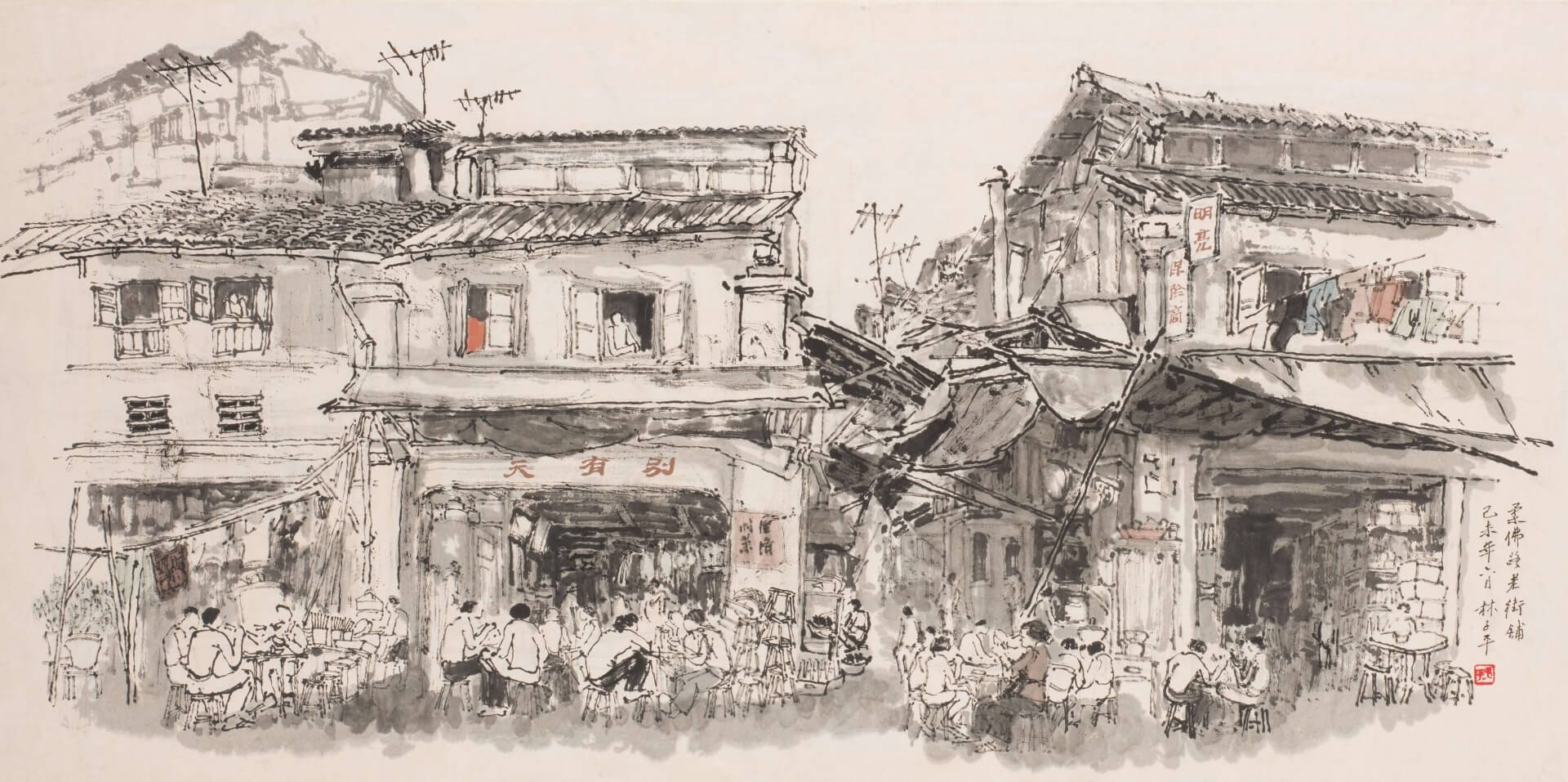书法艺术在新加坡的传承与发展
书法是华人传统教育课程中的一项必要的训练,其主要功能不外是实用。例如日常生活中的公私书信往来、记事或记账等。因此,20世纪初至1970年代,一般新加坡的华校都有毛笔字课。
二战前的书法活动状况
19世纪中期,华人已认识到教育的重要性。一般而言,早期华校课程“仍是沿习旧中国传统,教的不外《三字经》《千字文》《幼学琼林》以及四书五经之类,此外还兼习书法和珠算”。1私塾中教授书法主要还是以实用为主,例如,早期的华人商号使用的账簿,也多是整齐的工楷或行楷毛笔字。
在“南侨诗宗”邱菽园(1874-1941)与黄曼士(1890-1963)生活的时代,邱菽园的交往圈多为士人阶层,如文人、学者、艺术家与晚清政界人士,他们藉由书法这种书写表现形式作为文字的载体,为对方的绘画或收藏题跋,乃至诗词酬唱,甚至探讨思想与论政;而黄曼士所往来群体,大部份属于受过现代教育的文人、艺术家与知识分子。黄曼士的书房“百扇斋”,俨然是当时新加坡重要的沙龙。2邱菽园与黄曼士的交往圈,所代表的都是华人社会的中上层阶级,而且两个群体间也有重叠交往。总体而言,第二种群体,也就是黄曼士的交往圈,在推动本地书法的发展上较前者更为直接与积极。3

民间方面,随着19世纪末、20世纪上半叶大量的华人买棹南来,联系情谊的宗乡会馆与崇祀华人信仰的寺庙也陆续在本地建立。无论是哪一类建筑,都会延续中国的做法,请名家题写匾额或楹联。这很自然在传统建筑集中的中心地带形成一种视觉上的飨宴。坐落于直落亚逸街,始建于1839年的天福宫便是一例,正殿上方悬挂的“波靖南溟”四字便是光绪帝的手迹。始建于1898年的莲山双林寺,寺内的匾额与楹联书法,也都是近百年间的名家手笔,既有警示世人之效,也有美化丛林之功。至于宗乡会馆、社团方面,中国近代名家题写的匾额,则是随处可见。因此,这些场所的匾额或楹联,甚至包括所悬挂的墨迹,除了有说明的作用之外,也是本地华族文化重要的一种视觉艺术之遗产。
报人与南来的书画家
书法作为一种艺术表现形式,必须通过文人与艺术家的继承、创造发展才能形成时代的风格。若再经由媒体的传播,就能进入大众的审美视野。重要的战前报人,同时也是书画家的包括叶季允(1859-1921)与张叔耐(1895-1939)。叶季允主笔《叻报》40年,不仅是报人,也精通书画、篆刻、岐黄之术;张叔耐1919年抵新后,出任《新国民日报》主笔兼总编辑,也是新文学倡导前锋,本地许多店铺的匾额均出自他之手。此外,对推动书法艺术重要的人物还包括一些南来办展览或任职的书画家如潘受(1911-1999)、林学大(1893-1963)、黄火若(1910-1994)、何香凝(1878-1972)、徐悲鸿(1895-1953)、高冠天(1876-1949)与高剑父(1879-1951)两兄弟等。1937年卢沟桥事变后,也有一批文人艺术家相继南来,重要的有施香沱(1906-1990)、刘延陵(1894-1988)、刘海粟(1896-1994)与郁达夫(1896-1945)等。这些人或暂时居留,或在新加坡独立后成为公民,但都为本地的书法发展做出了贡献。


战后的华校书法教育
战后的新加坡华文教育非常发达。从战前至战后,直至1980年代教育改革之前,华校中小学一度达300多所。其中,几所重要的华校,如端蒙中学和中正中学,教员中不乏书法家(如陈景昭[1907-1972]、张瘦石[1898-1969]等),他们积极在校内推动书法教育。学生在书法方面更是人材辈出,每逢有书法比赛,无论中小学部,两校的学生总能独占鳌头。这两所学校培养出来的书法人材,不少已成为新加坡从1980年代至今书坛活跃的书家。执掌新加坡书法家协会的陈声桂便是出自中正。新加坡书法家协会每年新春都与不少民众俱乐部联合主办挥春比赛,藉此推动新加坡的书法发展,使之深入群众,成为大众艺术。
此外,陈人浩(1908-1976)于1956年至1969年掌校的德明政府华文中学(今德明政府中学),向来也重视书法予学生的熏陶。该校在成为特选中学后,学生学习书法依然是课程之一。本地书画家许梦丰既毕业于德明,也是陈人浩的学生。


私人授课与社团、美院的书法班
1960年代至今,私人教授书法者越来越多。私人开班教授书法的书画家包括施香沱与他的学生陈建坡(1949-2019)、曾纪策与张有铄,还有潘受、曾广纬、许梦丰、曾守荫、朱添寿与王运开等。1990年代后,中国新移民的书法人材的加入,也为本地书坛增添生力军,如郭书明、马双禄与孔令广等就是其中代表人物。
1970、80年代国家经济急速成长,国人消费能力增强,售卖文房四宝的店铺也多了。当时,售卖笔墨纸砚已不再只限于中华书局、商务印书馆与上海书局,“书城”百胜楼的金石书画社、四宝斋与金顺利等店铺为书法爱好者提供了更多的选择。1970年代,位于大坡的中华书局四楼的中华画廊,每个星期六下午四楼都有雅集。潘受在众人的围绕中提笔醮墨,无论条幅、对联、中堂或扇面,皆能顷刻完成,传为佳话。
1980年代教改后,华语文成为单科,学校的教学媒介语也改为英文,但各社团与民众俱乐部积极主办书法比赛依旧持续,直到今天。如今,新加坡书法家协会、多个民众俱乐部、南洋书法中心、啸涛书画篆刻会与南洋艺术学院等,都设有书法课程,为许多有心学习书法的民众提供更多的渠道。
社团活动展览促进书法发展
国庆美展自1969年举办第一届后,便成为一年一度的本地视觉艺术盛宴。从1970年代至1980年代的历届展览,新加坡第一、二代的书法家都有作品参展。同时,本地重要的美术团体,如中华美术研究会、啸涛篆刻书画、中华书画研究会(新加坡书协的前身)等,也积极地举办各种书画展。4除此之外,近代活跃的的书画团体如华翰书画研究会、墨澜社、兰亭画会等,都可视为本地书法发展的推手。
1980年代新加坡经济起飞,为了售卖书画而前来办展览的港台书画家也有增加的趋势。中国改革开放伊始,新加坡一些古玩店或画廊也很积极地办理中国现代书画家来新加坡开书画展,一则掀起一股收藏书画的热潮,二则刺激人们学习书法的欲望。
2000年后,新加坡每年几个重要的书法展,如新加坡常年书展、狮城墨韵、由义安文化中心主办的国庆书画美展与南洋书法展等也促使学习书法成为一种文化养生时尚,从青少年至中老年,许多人都成为书法展的弄潮儿。
回顾过去几十年,随着华校退出历史的舞台,教改后的新加坡书法活动并未归于沉寂,仍旧一片热闹、显露生机。
| 1 | 柯木林,〈崇文阁与萃英书院〉,收入林孝胜等合著,《石叻古迹》(新加坡:南洋学会,1975),页217-219。 |
| 2 | 施香沱记黄曼士言:“我的百扇斋真是往来无白丁。”参见:施香沱,〈百扇斋谈往〉,收入黄淑芬编,《黄曼士纪念文集》,页36。 |
| 3 | 黄曼士对本地书画艺人的鼓励与推动甚大,如,他曾代当时已年过七旬的画家陈亚士出售字画,助其渡过沦陷时期的困苦生活;1946年书法家崔大地(1903-1974)自曼谷来星洲拜访黄曼士,黄曼士鼓励崔大地举行书法展,并亲自为其奔忙。参见:马骏,〈沦陷时期的曼老〉,收入《黄曼士纪念文集》,页70-71。 |
| 5 | 《迈拓新纪元——中华美术研究会七十周年纪念集》,新加坡中华美术研究会,页19-20。该会在新加坡独立后,曾于1966年举办名人书法展;1969年举办黄载灵书画篆刻展;1972年再次办名家书法展;1976年10月当地书法展附展施香沱收藏碑帖216件;1977年主办明清名家书画展;1978年8月主办书法座谈会,与谈者有潘受、黄葆芳(1912-1989)、黄国良(1920-2004)、施香沱、庄声涛与陈声桂等人;1981年办饶宗颐(1917-2018)书画展。 另外,啸涛篆刻书画会自1973年始,每年的常年展,也为本地书坛做出了贡献。成立于1968年的中华书画研究会自1990年起办过多次的国际书法展;还有新日书法交流展、新中书法交流展、新台书法交流展、新马书法交流展、新韩书法交流展与新港书法交流展,这对推动与普及书法艺术起着重要作用。 |
陈培福,《夏虫语冰集》。新加坡:城市书房,2022。 | |
吕振端,〈三位名师造就了我〉。《南安艺文社》网页,新加坡南安会馆。 | |
黄淑芬编,《黄曼士纪念文集》。新加坡:南洋学会,1977。 |










